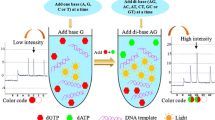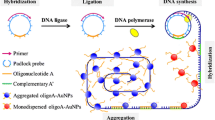Abstract
In this report, a simple, label-free and highly efficient nucleic acid amplification technique is developed for ultrasensitive detection of single-nucleotide polymorphism (SNP). Briefly, a designed padlock probe is first circularized by a DNA ligase when it perfectly complements to a mutant gene. Then, the mutant gene functions as a primer to initiate branched rolling circle amplification reaction (BRCA), generating a large number of branched DNA strands and a lot of pyrophosphate molecules which is equivalent to the number of nucleotides consumed. With the addition of a terpyridine–Zn(II) complex, pyrophosphate molecules can be sensitively detected owing to the formation of a fluorescent terpyridine–Zn(II)–pyrophosphate complex. The fluorescence intensity is directly associated with the content of the mutant gene in a sample solution. On the other hand, the circulation of the padlock probe is prohibited when it hybridizes with the wild-type gene. In this assay, the accumulative nature of the BRCA process produces a detection limit of 0.1 pM and an excellent selectivity factor of 1000 toward SNP. As little as 0.1% mutant in the wild-type gene can be successfully detected. The simple procedure, high sensitivity, and high selectivity of this assay offer a potentially viable alternative for routine SNP analysis.

A simple and label-free fluorescence assay for SNP detection by coupling BRCA with selective fluorescence detection of pyrophosphate using the terpyridine–Zn(II) complex.







Similar content being viewed by others
References
Sachidanandam R, Weissman D, Schmidt SC, Kakol JM, Stein LD, Marth G, et al. A map of human genome sequence variation containing 1.42 million single nucleotide polymorphisms. Nature. 2001;409(6822):928–33.
Hood L, Heath JR, Phelps ME, Lin B. Systems biology and new technologies enable predictive and preventative medicine. Science. 2004;306(5696):640–3.
Kim S, Misra A. SNP genotyping: technologies and biomedical applications. Annu Rev Biomed Eng. 2007;9:289–320. https://doi.org/10.1146/annurev.bioeng.9.060906.152037.
Irizarry K, Kustanovich V, Li C, Brown N, Nelson S, Wong W, et al. Genome-wide analysis of single-nucleotide polymorphisms in human expressed sequences. Nat Genet. 2000;26(2):233–6.
McCarthy JJ, Hilfiker R. The use of single-nucleotide polymorphism maps in pharmacogenomics. Nat Biotechnol. 2000;18(5):505–8.
Chang K, Deng S, Chen M. Novel biosensing methodologies for improving the detection of single nucleotide polymorphism. Biosens Bioelectron. 2015;66:297–307. https://doi.org/10.1016/j.bios.2014.11.041.
Syvänen AC. Accessing genetic variation: genotyping single nucleotide polymorphisms. Nat Rev Genet. 2001;2(12):930–42.
Deng H, Shen W, Gao Z. Colorimetric detection of single nucleotide polymorphisms in the presence of 10(3)-fold excess of a wild-type gene. Biosens Bioelectron. 2015;68:310–5. https://doi.org/10.1016/j.bios.2015.01.016.
Teo AKL, Lim CL, Gao Z. The development of electrochemical assays for microRNAs. Electrochim Acta. 2014;126:19–30. https://doi.org/10.1016/j.electacta.2013.06.113.
Shen W, Lim CL, Gao Z. A ferrofluid-based homogeneous assay for highly sensitive and selective detection of single-nucleotide polymorphisms. Chem Commun (Camb). 2013;49(73):8114–6. https://doi.org/10.1039/c3cc43281e.
Doerks T, Copley RR, Schultz J, Ponting CP, Bork P. Systematic identification of novel protein domain families associated with nuclear functions. Genome Res. 2002;12(1):47–56. https://doi.org/10.1101/gr.203201.
Wee EJ, Shiddiky MJ, Brown MA, Trau M. eLCR: electrochemical detection of single DNA base changes via ligase chain reaction. Chem Commun (Camb). 2012;48(98):12014–6. https://doi.org/10.1039/c2cc35841g.
Shen W, Deng H, Teo AK, Gao Z. Colorimetric detection of single-nucleotide polymorphisms with a real-time PCR-like sensitivity. Chem Commun (Camb). 2012;48(82):10225–7. https://doi.org/10.1039/c2cc35070j.
Lizardi PM, Huang X, Zhu Z, Bray-Ward P, Thomas DC, Ward DC. Mutation detection and single-molecule counting using isothermal rolling-circle amplification. Nat Genet. 1998;19(3):225–32.
Demidov VV. Rolling-circle amplification in DNA diagnostics: the power of simplicity. Expert Rev Mol Diagn. 2002;2(6):542–8. https://doi.org/10.1586/14737159.2.6.542.
Nilsson M, Malmgren H, Samiotaki M, Kwiatkowski M, Chowdhary B, Landegren U. Padlock probes: circularizing oligonucleotides for localized DNA detection. Science. 1994;265(5181):2085–8. https://doi.org/10.1126/science.7522346.
Hamidi SV, Ghourchian H. Colorimetric monitoring of rolling circle amplification for detection of H5N1 influenza virus using metal indicator. Biosens Bioelectron. 2015;72:121–6. https://doi.org/10.1016/j.bios.2015.04.078.
Larsson C, Koch J, Nygren A, Janssen G, Raap AK, Landegren U, et al. In situ genotyping individual DNA molecules by target-primed rolling-circle amplification of padlock probes. Nat Methods. 2004;1(3):227–32. https://doi.org/10.1038/nmeth723.
Blab GA, Schmidt T, Nilsson M. Homogeneous detection of single rolling circle replication products. Anal Chem. 2004;76(2):495–8.
Cheng Y, Li Z, Du B, Zhang X. Homogeneous and label-free bioluminescence detection of single nucleotide polymorphism with rolling circle amplification. Analyst. 2008;133(6):750–2. https://doi.org/10.1039/b803954m.
Banér J, Nilsson M, Mendel-Hartvig M, Landegren U. Signal amplification of padlock probes by rolling circle replication. Nucleic Acids Res. 1998;26(22):5073–8.
Smolina IV, Cherny DI, Nietupski RM, Beals T, Smith JH, Lane DJ, et al. High-density fluorescently labeled rolling-circle amplicons for DNA diagnostics. Anal Biochem. 2005;347(1):152–5. https://doi.org/10.1016/j.ab.2005.06.002.
Zipper H, Brunner H, Bernhagen J, Vitzthum F. Investigations on DNA intercalation and surface binding by SYBR green I, its structure determination and methodological implications. Nucleic Acids Res. 2004;32(12):e103.
Giglio S, Monis PT, Saint CP. Demonstration of preferential binding of SYBR green I to specific DNA fragments in real-time multiplex PCR. Nucleic Acids Res. 2003;31(22):e136.
Smolina IV, Demidov VV, Cantor CR, Broude NE. Real-time monitoring of branched rolling-circle DNA amplification with peptide nucleic acid beacon. Anal Biochem. 2004;335(2):326–9. https://doi.org/10.1016/j.ab.2004.07.022.
Kong F, Tong Z, Chen X, Sorrell T, Wang B, Wu Q, et al. Rapid identification and differentiation of Trichophyton species, based on sequence polymorphisms of the ribosomal internal transcribed spacer regions, by rolling-circle amplification. J Clin Microbiol. 2008;46(4):1192–9. https://doi.org/10.1128/JCM.02235-07.
Gudnason H, Dufva M, Bang DD, Wolff A. Comparison of multiple DNA dyes for real-time PCR: effects of dye concentration and sequence composition on DNA amplification and melting temperature. Nucleic Acids Res. 2007;35(19):e127.
Mori Y, Nagamine K, Tomita N, Notomi T. Detection of loop-mediated isothermal amplification reaction by turbidity derived from magnesium pyrophosphate formation. Biochem Biophys Res Commun. 2001;289(1):150–4.
Kim SK, Lee DH, Hong J-I, Yoon J. Chemosensors for pyrophosphate. Acc Chem Res. 2008;42(1):23–31.
Lee DH, Kim SY, Hong JI. A fluorescent pyrophosphate sensor with high selectivity over ATP in water. Angew Chem Int Ed. 2004;43(36):4777–80.
Bhowmik S, Ghosh BN, Marjomaki V, Rissanen K. Nanomolar pyrophosphate detection in water and in a self-assembled hydrogel of a simple terpyridine–Zn2+ complex. J Am Chem Soc. 2014;136(15):5543–6. https://doi.org/10.1021/ja4128949.
Zhang S, Wu Z, Shen G, Yu R. A label-free strategy for SNP detection with high fidelity and sensitivity based on ligation-rolling circle amplification and intercalating of methylene blue. Biosens Bioelectron. 2009;24(11):3201–7. https://doi.org/10.1016/j.bios.2009.03.012.
Brookes AJ. The essence of SNPs. Gene. 1999;234(2):177–86.
Fire A, Xu S-Q. Rolling replication of short DNA circles. Proc Natl Acad Sci. 1995;92(10):4641–5.
Zhao W, Ali MM, Brook MA, Li Y. Rolling circle amplification: applications in nanotechnology and biodetection with functional nucleic acids. Angew Chem Int Ed. 2008;47(34):6330–7.
Mocak J, Bond AM, Mitchell S. A statistical overview of standard (IUPAC and ACS) and new procedures for determining the limits of detection and quantification: application to voltammetric and stripping techniques (technical report). Pure Appl Chem. 1997;69(2):297–328.
Liu X, Li T, Liu D, Wang Z. Fabricating three-dimensional hydrogel oligonucleotide microarrays to detect single nucleotide polymorphisms. Anal Methods. 2013;5(1):285–90. https://doi.org/10.1039/c2ay25904d.
Sun Y, Lu X, Su F, Wang L, Liu C, Duan X, et al. Real-time fluorescence ligase chain reaction for sensitive detection of single nucleotide polymorphism based on fluorescence resonance energy transfer. Biosens Bioelectron. 2015;74:705–10. https://doi.org/10.1016/j.bios.2015.07.028.
Xu J, Wu ZS, Li H, Wang Z, Le J, Zheng T, et al. Dual-cyclical nucleic acid strand-displacement polymerization based signal amplification system for highly sensitive determination of p53 gene. Biosens Bioelectron. 2016;86:1024–30. https://doi.org/10.1016/j.bios.2016.07.029.
Heo HY, Chung S, Kim YT, Kim DH, Seo TS. A valveless rotary microfluidic device for multiplex point mutation identification based on ligation-rolling circle amplification. Biosens Bioelectron. 2016;78:140–6. https://doi.org/10.1016/j.bios.2015.11.039.
Gao J, Ma L, Lei Z, Wang Z. Multiple detection of single nucleotide polymorphism by microarray-based resonance light scattering assay with enlarged gold nanoparticle probes. Analyst. 2016;141(5):1772–8. https://doi.org/10.1039/c5an02510a.
Huang SQ, Hu J, Zhu G, Zhang CY. Sensitive detection of point mutation using exponential strand displacement amplification-based surface enhanced Raman spectroscopy. Biosens Bioelectron. 2015;65:191–7. https://doi.org/10.1016/j.bios.2014.10.035.
Zhu X, Shen Y, Cao J, Yin L, Ban F, Shu Y, et al. Detection of microRNA SNPs with ultrahigh specificity by using reduced graphene oxide-assisted rolling circle amplification. Chem Commun (Camb). 2015;51(49):10002–5. https://doi.org/10.1039/c5cc02039e.
Fang GM, Seitz O. Bivalent display of dicysteine on peptide nucleic acids for homogenous DNA/RNA detection through in situ fluorescence labelling. Chembiochem. 2017;18(2):189–94. https://doi.org/10.1002/cbic.201600623.
Acknowledgements
Financial support of this work by the Ministry of Education is gratefully acknowledged.
Author information
Authors and Affiliations
Corresponding author
Ethics declarations
Conflict of interest
The authors declare that they have no conflict of interest.
Electronic supplementary material
ESM 1
(PDF 566 kb)
Rights and permissions
About this article
Cite this article
Ma, Q., Gao, Z. A simple and ultrasensitive fluorescence assay for single-nucleotide polymorphism. Anal Bioanal Chem 410, 3093–3100 (2018). https://doi.org/10.1007/s00216-018-0874-4
Received:
Revised:
Accepted:
Published:
Issue Date:
DOI: https://doi.org/10.1007/s00216-018-0874-4




